Comparison of wireless alarm sets Ajax StarterKit and Xiaomi Smart Home Suite
Choosing a home alarm system for self-installation, we traditionally solve the dilemma: choose something cheaper on Aliexpress with delivery from China, buy the same from local resellers “from there” a little more expensive, or look for luck among more expensive products, including local production.
Well, to solve the dilemma, let's "face together" the two freshest home alarms: Xiaomi Smart Home Suite http://www.citrus.ua/shop/goods/rozetki-i-datchiki/2151/251829 and Ajax StarterKit http: //secur.ua/ajax .
Since my last review of home alarms ( https://geektimes.ru/post/240588/) a lot has changed. The world is moving in the direction of the Internet of things, and the alarms are also "in trend." If previous models relied on GSM, then modern cloud and P2P technologies are already relevant. Now alarms are easily (theoretically) controlled from a smartphone, and all suspicious events noticed are reported to the smartphone.
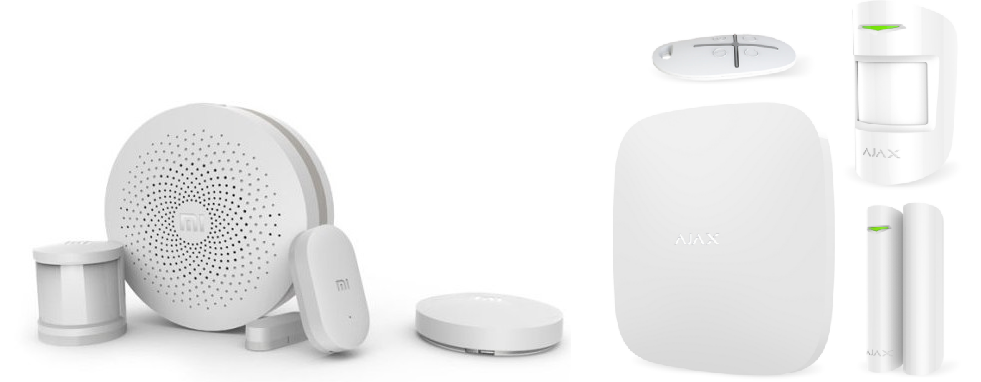
Package
The Xiaomi set comes in a box, three times smaller than the box in Ajax. But at Ajax all the elements inside the common box are also packed in individual boxes, with separate instructions for each device.

Boxes Xiaomi Smart Home Suite (top) and Ajax StarterKit (bottom).
Opening the Xiaomi Smart Home Suite package, you are surprised and remember the cartoon “Fixics”. "They are such a trifle that they are almost nonexistent ..." - this is exactly about Xiaomi gadgets. Motion sensor and opening sensor are miniature here. I do not presume to judge whether this is good or bad. In the end, if they work well, then what's the difference?
In total, Xiaomi detects: a cylindrical motion sensor, an opening sensor with a magnet to boot, a surprisingly not a small call button and, the basis of the Smart Home Suite system, a controller that manages the entire economy.

Xiaomi Smart Home Suite Kit The Xiaomi
controller plugs directly into a power outlet, but ... It has a three-prong Chinese plug.
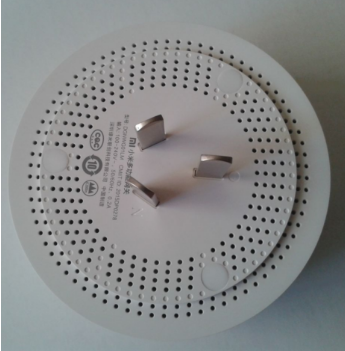
Xiaomi controller plug
Therefore, you need an adapter to connect the device to the euro socket. Because of the adapter, the design will lose some of the aesthetic appeal, but it is quite possible to put up with it - the model is not officially supplied to our market and there is no need to blame the “Chinese” plug.
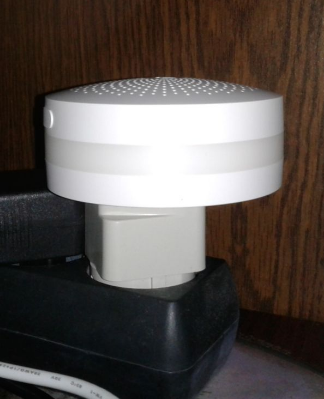
Xiaomi controller with an adapter
To the alarm kit is attached instruction in incomprehensible Chinese. I suspect that the majority of domestic users cannot master this instruction even with a dictionary. Fortunately, there are a couple of illustrations at least giving hints about what's what.
The Ajax kit contains an Ajax Hub controller, a motion sensor of more conventional dimensions and even a slightly stylish look, the opening sensor here is completed immediately with a large and a small magnet (which is illustrated further). Plus included is the usual key chain to control the alarm.
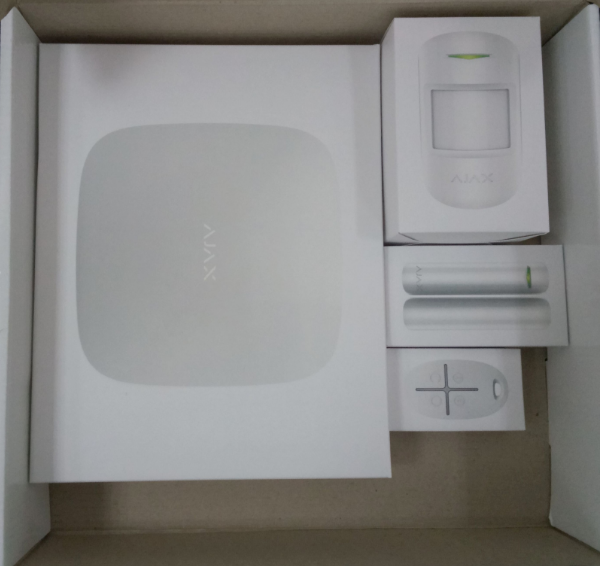
Ajax StarterKit Kit
As already mentioned, a good instruction in Russian is attached to each sensor and even a key fob. In the box with Ajax Hub there is an illustrated booklet “Quick start”, which in an accessible form explains how to set up the joint operation of all the devices in the kit. Therefore, the connection of the Ajax kit as a whole is more convenient and faster, since the Xiaomi variant often requires a non-obvious method of “scientific poking”.
Easy installation and connection
If the Xiaomi controller is securely inserted into the outlet, then about the reliability of the mounting sensors can not say much good. The tiny motion sensor has a bottom rubber stand on which it should stand. You can "stick" the sensor and the supplied adhesive tape, for example in a horizontal position. Miniature has its advantage - a small wireless sensor is easier to hide in the interior.

Motion sensors Xiaomi
However, there are also disadvantages. If you have not only ants and cockroaches from pets, the sensor can not stand in place ... A cat, a parrot, a chinchilla, a dog or some other pet will surely want to “play” with the device, or even chew it. And then the sensor can come the end of the fox.
The motion sensor Ajax Motion Protect has a special mounting plate, which is mounted on the screws (they are also included). And the possibility of mounting in the corner, which is an undoubted advantage of the design.
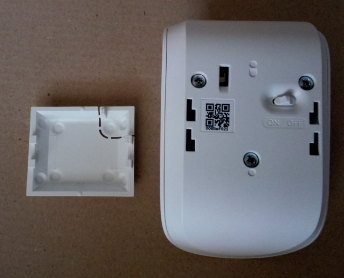
Fixing panel of the Ajax motion sensor
When attaching the sensor to the mounting panel, the tamper button is clamped - and the controller always knows that the sensor is in place.
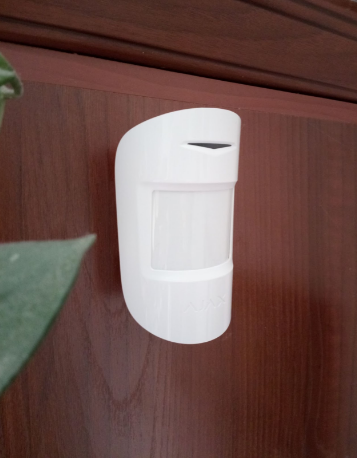
Ajax motion sensor in the interior.
But the tiny Xiaomi sensor, the child can safely lie in the pocket and carry to the playground to play - the alarm will be all the same.
Although the Ajax motion sensor looks larger, it has several times more functionality: it is protection against tearing / opening, sensitivity setting, and two-way communication with the controller, which allows you to inform about the battery status, etc.
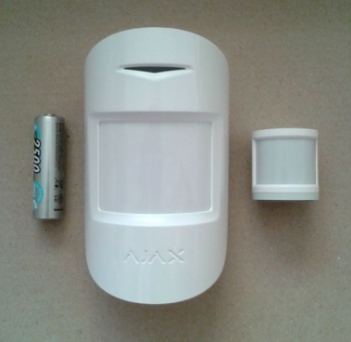
Size comparison of motion sensors
The Xiaomi opening sensor has the same Achilles' heel with a mount - only for double-sided tape. If this option is even more or less for a door, then it is not very suitable for a window - drafts, summer heat and winter cold will inevitably cause accelerated degradation of adhesive tape, and the sensor or magnet will disappear, causing a false alarm. And given the small size of the magnet, it can be quietly vacuumed while cleaning. Then look for the "wind in the dust field" ...

Comparing the size of the opening sensors
The Ajax DoorProtect opening sensor is mounted on a special mount, which in turn is attached to a door or window on self-tapping screws. This is a much more reliable decision; in the area of security, relying on tape is somehow not made. Again, the sensor has a tamper button confirming the alarms that the device is in place.

Fixing panel of the Ajax opening sensor
Two sensors are needed for the sensor, so I will quote the instruction: “A small magnet is more suitable for the installation option when the closed door and the jamb are perpendicular. A large magnet is better suited for the installation option when the closed door and the joint are parallel. " In general, see the photo.

Ajax small magnet opening sensor (when door and jamb are perpendicular)
The Xiaomi button assumes the functionality of the doorbell (it is unlikely that someone will use it so much, because the button is very easy to steal) or the call button. The latter is much closer to reality. A child or an elderly / sick person can signal to their parents / nurse / nurse that they need something.

Button Xiaomi
Ajax Keyfob can not serve as a call button, but it is designed for easy arming / disarming the alarm without using a smartphone. Let's be frank, not every child or pensioner has a smartphone. But the keychain for each provides an easy and convenient way to interact with the alarm. The physical key fob works in parallel with the control from a smartphone, which implements a similar “virtual” key fob, about which a little further.

Keychain Ajax
Functionality and features of use
The Xiaomi Smart Home Suite system connects to your home router via a wireless Wi-Fi network. Ajax connects to the router via a wired Ethernet connection.
The wireless connection option is certainly more convenient, since it does not require the user to pull the cables around the apartment.

Connecting Power and Ethernet Cables to the Ajax
Controller The controllers of both systems use proprietary mobile applications to interact with signaling. Thanks to cloud services, the smartphone quietly connects to the P2P signaling controller without the need for complicated network equipment settings and other difficulties. Both sets have versions of applications for iOS and Android. We will use the green robot option.
It's amazing, but the application Xiaomi MiHome flatly refused to be installed on smartphones and tablets with Android 4.2.2. It seems that the Chinese have lost touch with reality and decided to be at the very peak of progress. Ajax had no problems with the Android version, but in the end both systems were tested on a smartphone with Android 5.1.
MiHome app is available on PlayMarket.

MiHome application
To work with Xiaomi Smart Home Suite, the program requires mandatory account registration, without this you cannot even enter a password to the Wi-Fi network.
After registration, the controller with Xiaomi Smart Home Suite will be added to the list of devices of the application, and clicking on it will take you to the main interface of the program. Despite the fact that the application seems to be officially in English, the Chinese characters are waiting for us in the depths of the program.

Management Interface Xiaomi Smart Home Suite
Despite the Chinese, the essence can catch. Circular slider adjusts the brightness of the backlight "night light". By default, this color is bright white and "hits" in the eyes even during the day, not to mention the night. Therefore, the backlight was adjusted to a dim blue. The backlight, by the way, without a smartphone is turned on with a single press of the controller button.
By clicking on the image of the sensor, you can see the event log. Here is an example of the motion sensor.

Motion sensor event log
Unfortunately, there are no “fine” settings for the sensor sensitivity type (to ignore domestic animals represented by cats and doggies).
When you first downloaded the application, by the way, it turned out to work with the controller, demanding to update the firmware. After updating the firmware, the program immediately demanded ... Roll one more. Well, the release of new firmware is a positive.

A consistent update of the firmware of the Xiaomi controller The firmware was
not updated in vain: after installing the latest version, the Xiaomi system became noticeably faster. The initial initialization and arming procedure has accelerated significantly! If arming the original firmware for about a minute, now the controller began to cope with this in a few seconds. Fine.
Without a smartphone, the Xiaomi alarm system is armed by double pressing the controller button. Leaving the house, the user will surely disturb the activated sensors of opening and movement, but this is not critical - after they are triggered, the system will calm down and continue to work in guard mode, having slightly activated the siren and sending notifications. Siren with adjustable power, but in general, not too loud, it may not be audible even in the next room or in the kitchen when operating at medium volume TV. So the alarm system will not disturb the neighbors exactly. You can manually disarm the alarm by pressing the button once on the controller.
When enabled, the Xiaomi controller says something in Chinese. But with the loss of power, the Xiaomi alarm system silently turns off completely, and the user will not know about it. Only with the reappearance of power to the smartphone comes a notification about this event ... In Chinese. And all notifications about alarm events recorded by sensors come with Beijing time and in pure Chinese. Do you understand everything? )

Notification from Xiaomi Smart Home Suite
Xiaomi sensors work fine, no complaints. The only thing, as already mentioned, when the sensors "took away", the system does not notice the loss of a fighter, their absence during arming. Sadly, the Xiaomi system is completely defenseless against acts of sabotage and vandalism. Why - it is not clear. It is hard to believe that quite often honest pioneers are around China, who conscientiously collect scrap metal and waste paper, but never pioneer anything.
Xiaomi sensors are synchronized with the controller by pressing a button that is deeply recessed in the case. You need to press using the special key included in the kit. After successful synchronization, the controller will issue a winning beep, and the MiHome application list will appear on the sensor.
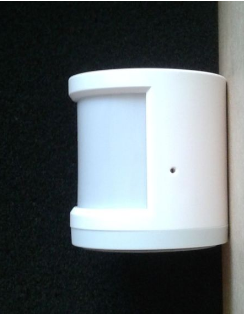
Hole on the motion sensor Xiaomi to enable synchronization with the controller
Disassembling Xiaomi sensors to replace batteries seemed a rather trivial task with a high risk of breaking the plastic latches.
Ajax sensors are turned on with convenient buttons, and disassembled with bare hands and a screwdriver. The only difficulty is the keyring - it is quite difficult to open it to replace the battery.
Ajax sensors are also not originally synchronized with the controller. Fortunately, russified mobile application comes to the rescue.

Mobile application Ajax
Here you also need a mandatory user registration, after passing which we get into the program menu, which offers a step-by-step manual for connecting the entire system.

Ajax Mobile Guide
The procedure for connecting new devices through a mobile application is not difficult and is as clear as possible thanks to the Russian language. The controller and sensors are added using a unique identifier, or using a QR code.

Adding Ajax devices The
sensors here have two-way communication with the controller and inform you about the attempt to remove the sensor, about the discharge of batteries, etc. The system maintains a detailed event log.

Display of statuses and events
Notifications about events to the user come in Russian, taking into account the specific room and the activated sensor.

Ajax notifications
For arming instead of physical, you can use such a virtual key fob, which even LED display works.

Ajax Virtual Keychain
Unlike Xiaomi, the Ajax system has a built-in battery that allows you to work without electricity for up to 10 hours. And as a backup communication channel, GSM communication is used - you will receive a message about the incident, regardless of whether the network router or the electricity in the house is working.

Notifications about the loss and restoration of power
The timing of the wireless sensors. Xiaomi uses small flat batteries in them and claims a work period of up to two years. The model of the battery used is written on the bottom of each sensor and button, which is convenient. Ajax uses large lithium batteries, and the sensor life is up to 7 years. This is a very optimistic forecast. In reality, everything will depend on the number of actuations and the sensor installation distance from the controller - the closer, the more power consumption of the sensor decreases. Also, autonomy is influenced by the user-selected sensor polling frequency (this is for transmitting service information about the status of sensors, the alarm signal is transmitted immediately), which is adjustable in the interval from 12 to 300 seconds. By the way, the range of work for Ajax sensors is up to 2 km, but not indoors, of course. For the premises stated several floors of the business center. To check the communication range, I used “carried away” opening sensors from both alarms. In terms of distance, Ajax won, unsurprisingly, the controller caught the signal even on the floor above and below, while the signal from the Xiaomi sensor was lost on the elevator platform at a distance of about 20 m from the controller, behind 4 concrete walls.
The advantages of Ajax can include such more professional features as signal encryption (protection against interception), detection of jamming attempts and frequency hopping in case of strong interference on the radio channel used.
Summary
The Xiaomi Smart Home Suite system attracts with its low price, excellent appearance and the function of a colored night lamp. It is easy to install and master, even though there is no Russification of the mobile application. At the same time, the lack of anti-tampering features and the complete loss of communication in case of problems with power supply or wireless network do not allow recommending this model as a reliable security solution.
Ajax StarterKit is more expensive, and larger in size. But the design also looks very good, but in terms of performance, it is significantly superior to the set from Xiaomi. Ajax can offer long distances to work with sensors and constantly monitors their performance. The Ajax system can go without power for several hours, and if a wired network is lost, it switches to a backup GSM wireless connection without losing contact with the owner. All this is extremely important for the reliability of the security system, on which the security of the property depends.
Pros and cons:
Xiaomi Smart Home Suite
+ Small dimensions
+ Wireless connection
+ Attractive design
+ Night light function
+ Smartphone control
+ Reliable sensor operation
+ Expansion options for new sensors and devices
+ Affordable price
- Protection before sabotage
- Lack of battery backup power
- Short range sensor operation
- Mobile application with
Ajax StarterKit interface in Chinese
+ Attractive design
+ Dual LAN / GSM communication
control + GSM card balance
+ Adjust the sensitivity of the sensors
+ expansion with new sensors and devices
+ convenient control from your smartphone and Russification applications
+ protection from botazha
+ Built-in backup battery
+ Long range sensors work
+ Keychain for easy arming / disarming
+ Can connect to the console security systems
- No siren included, only for “extra charge”
- Relatively high price
Well, to solve the dilemma, let's "face together" the two freshest home alarms: Xiaomi Smart Home Suite http://www.citrus.ua/shop/goods/rozetki-i-datchiki/2151/251829 and Ajax StarterKit http: //secur.ua/ajax .
Since my last review of home alarms ( https://geektimes.ru/post/240588/) a lot has changed. The world is moving in the direction of the Internet of things, and the alarms are also "in trend." If previous models relied on GSM, then modern cloud and P2P technologies are already relevant. Now alarms are easily (theoretically) controlled from a smartphone, and all suspicious events noticed are reported to the smartphone.

Package
The Xiaomi set comes in a box, three times smaller than the box in Ajax. But at Ajax all the elements inside the common box are also packed in individual boxes, with separate instructions for each device.

Boxes Xiaomi Smart Home Suite (top) and Ajax StarterKit (bottom).
Opening the Xiaomi Smart Home Suite package, you are surprised and remember the cartoon “Fixics”. "They are such a trifle that they are almost nonexistent ..." - this is exactly about Xiaomi gadgets. Motion sensor and opening sensor are miniature here. I do not presume to judge whether this is good or bad. In the end, if they work well, then what's the difference?
In total, Xiaomi detects: a cylindrical motion sensor, an opening sensor with a magnet to boot, a surprisingly not a small call button and, the basis of the Smart Home Suite system, a controller that manages the entire economy.

Xiaomi Smart Home Suite Kit The Xiaomi
controller plugs directly into a power outlet, but ... It has a three-prong Chinese plug.

Xiaomi controller plug
Therefore, you need an adapter to connect the device to the euro socket. Because of the adapter, the design will lose some of the aesthetic appeal, but it is quite possible to put up with it - the model is not officially supplied to our market and there is no need to blame the “Chinese” plug.

Xiaomi controller with an adapter
To the alarm kit is attached instruction in incomprehensible Chinese. I suspect that the majority of domestic users cannot master this instruction even with a dictionary. Fortunately, there are a couple of illustrations at least giving hints about what's what.
The Ajax kit contains an Ajax Hub controller, a motion sensor of more conventional dimensions and even a slightly stylish look, the opening sensor here is completed immediately with a large and a small magnet (which is illustrated further). Plus included is the usual key chain to control the alarm.

Ajax StarterKit Kit
As already mentioned, a good instruction in Russian is attached to each sensor and even a key fob. In the box with Ajax Hub there is an illustrated booklet “Quick start”, which in an accessible form explains how to set up the joint operation of all the devices in the kit. Therefore, the connection of the Ajax kit as a whole is more convenient and faster, since the Xiaomi variant often requires a non-obvious method of “scientific poking”.
Easy installation and connection
If the Xiaomi controller is securely inserted into the outlet, then about the reliability of the mounting sensors can not say much good. The tiny motion sensor has a bottom rubber stand on which it should stand. You can "stick" the sensor and the supplied adhesive tape, for example in a horizontal position. Miniature has its advantage - a small wireless sensor is easier to hide in the interior.

Motion sensors Xiaomi
However, there are also disadvantages. If you have not only ants and cockroaches from pets, the sensor can not stand in place ... A cat, a parrot, a chinchilla, a dog or some other pet will surely want to “play” with the device, or even chew it. And then the sensor can come the end of the fox.
The motion sensor Ajax Motion Protect has a special mounting plate, which is mounted on the screws (they are also included). And the possibility of mounting in the corner, which is an undoubted advantage of the design.

Fixing panel of the Ajax motion sensor
When attaching the sensor to the mounting panel, the tamper button is clamped - and the controller always knows that the sensor is in place.

Ajax motion sensor in the interior.
But the tiny Xiaomi sensor, the child can safely lie in the pocket and carry to the playground to play - the alarm will be all the same.
Although the Ajax motion sensor looks larger, it has several times more functionality: it is protection against tearing / opening, sensitivity setting, and two-way communication with the controller, which allows you to inform about the battery status, etc.

Size comparison of motion sensors
The Xiaomi opening sensor has the same Achilles' heel with a mount - only for double-sided tape. If this option is even more or less for a door, then it is not very suitable for a window - drafts, summer heat and winter cold will inevitably cause accelerated degradation of adhesive tape, and the sensor or magnet will disappear, causing a false alarm. And given the small size of the magnet, it can be quietly vacuumed while cleaning. Then look for the "wind in the dust field" ...

Comparing the size of the opening sensors
The Ajax DoorProtect opening sensor is mounted on a special mount, which in turn is attached to a door or window on self-tapping screws. This is a much more reliable decision; in the area of security, relying on tape is somehow not made. Again, the sensor has a tamper button confirming the alarms that the device is in place.

Fixing panel of the Ajax opening sensor
Two sensors are needed for the sensor, so I will quote the instruction: “A small magnet is more suitable for the installation option when the closed door and the jamb are perpendicular. A large magnet is better suited for the installation option when the closed door and the joint are parallel. " In general, see the photo.

Ajax small magnet opening sensor (when door and jamb are perpendicular)
The Xiaomi button assumes the functionality of the doorbell (it is unlikely that someone will use it so much, because the button is very easy to steal) or the call button. The latter is much closer to reality. A child or an elderly / sick person can signal to their parents / nurse / nurse that they need something.

Button Xiaomi
Ajax Keyfob can not serve as a call button, but it is designed for easy arming / disarming the alarm without using a smartphone. Let's be frank, not every child or pensioner has a smartphone. But the keychain for each provides an easy and convenient way to interact with the alarm. The physical key fob works in parallel with the control from a smartphone, which implements a similar “virtual” key fob, about which a little further.

Keychain Ajax
Functionality and features of use
The Xiaomi Smart Home Suite system connects to your home router via a wireless Wi-Fi network. Ajax connects to the router via a wired Ethernet connection.
The wireless connection option is certainly more convenient, since it does not require the user to pull the cables around the apartment.

Connecting Power and Ethernet Cables to the Ajax
Controller The controllers of both systems use proprietary mobile applications to interact with signaling. Thanks to cloud services, the smartphone quietly connects to the P2P signaling controller without the need for complicated network equipment settings and other difficulties. Both sets have versions of applications for iOS and Android. We will use the green robot option.
It's amazing, but the application Xiaomi MiHome flatly refused to be installed on smartphones and tablets with Android 4.2.2. It seems that the Chinese have lost touch with reality and decided to be at the very peak of progress. Ajax had no problems with the Android version, but in the end both systems were tested on a smartphone with Android 5.1.
MiHome app is available on PlayMarket.

MiHome application
To work with Xiaomi Smart Home Suite, the program requires mandatory account registration, without this you cannot even enter a password to the Wi-Fi network.
After registration, the controller with Xiaomi Smart Home Suite will be added to the list of devices of the application, and clicking on it will take you to the main interface of the program. Despite the fact that the application seems to be officially in English, the Chinese characters are waiting for us in the depths of the program.

Management Interface Xiaomi Smart Home Suite
Despite the Chinese, the essence can catch. Circular slider adjusts the brightness of the backlight "night light". By default, this color is bright white and "hits" in the eyes even during the day, not to mention the night. Therefore, the backlight was adjusted to a dim blue. The backlight, by the way, without a smartphone is turned on with a single press of the controller button.
By clicking on the image of the sensor, you can see the event log. Here is an example of the motion sensor.

Motion sensor event log
Unfortunately, there are no “fine” settings for the sensor sensitivity type (to ignore domestic animals represented by cats and doggies).
When you first downloaded the application, by the way, it turned out to work with the controller, demanding to update the firmware. After updating the firmware, the program immediately demanded ... Roll one more. Well, the release of new firmware is a positive.

A consistent update of the firmware of the Xiaomi controller The firmware was
not updated in vain: after installing the latest version, the Xiaomi system became noticeably faster. The initial initialization and arming procedure has accelerated significantly! If arming the original firmware for about a minute, now the controller began to cope with this in a few seconds. Fine.
Without a smartphone, the Xiaomi alarm system is armed by double pressing the controller button. Leaving the house, the user will surely disturb the activated sensors of opening and movement, but this is not critical - after they are triggered, the system will calm down and continue to work in guard mode, having slightly activated the siren and sending notifications. Siren with adjustable power, but in general, not too loud, it may not be audible even in the next room or in the kitchen when operating at medium volume TV. So the alarm system will not disturb the neighbors exactly. You can manually disarm the alarm by pressing the button once on the controller.
When enabled, the Xiaomi controller says something in Chinese. But with the loss of power, the Xiaomi alarm system silently turns off completely, and the user will not know about it. Only with the reappearance of power to the smartphone comes a notification about this event ... In Chinese. And all notifications about alarm events recorded by sensors come with Beijing time and in pure Chinese. Do you understand everything? )

Notification from Xiaomi Smart Home Suite
Xiaomi sensors work fine, no complaints. The only thing, as already mentioned, when the sensors "took away", the system does not notice the loss of a fighter, their absence during arming. Sadly, the Xiaomi system is completely defenseless against acts of sabotage and vandalism. Why - it is not clear. It is hard to believe that quite often honest pioneers are around China, who conscientiously collect scrap metal and waste paper, but never pioneer anything.
Xiaomi sensors are synchronized with the controller by pressing a button that is deeply recessed in the case. You need to press using the special key included in the kit. After successful synchronization, the controller will issue a winning beep, and the MiHome application list will appear on the sensor.

Hole on the motion sensor Xiaomi to enable synchronization with the controller
Disassembling Xiaomi sensors to replace batteries seemed a rather trivial task with a high risk of breaking the plastic latches.
Ajax sensors are turned on with convenient buttons, and disassembled with bare hands and a screwdriver. The only difficulty is the keyring - it is quite difficult to open it to replace the battery.
Ajax sensors are also not originally synchronized with the controller. Fortunately, russified mobile application comes to the rescue.

Mobile application Ajax
Here you also need a mandatory user registration, after passing which we get into the program menu, which offers a step-by-step manual for connecting the entire system.

Ajax Mobile Guide
The procedure for connecting new devices through a mobile application is not difficult and is as clear as possible thanks to the Russian language. The controller and sensors are added using a unique identifier, or using a QR code.

Adding Ajax devices The
sensors here have two-way communication with the controller and inform you about the attempt to remove the sensor, about the discharge of batteries, etc. The system maintains a detailed event log.

Display of statuses and events
Notifications about events to the user come in Russian, taking into account the specific room and the activated sensor.

Ajax notifications
For arming instead of physical, you can use such a virtual key fob, which even LED display works.

Ajax Virtual Keychain
Unlike Xiaomi, the Ajax system has a built-in battery that allows you to work without electricity for up to 10 hours. And as a backup communication channel, GSM communication is used - you will receive a message about the incident, regardless of whether the network router or the electricity in the house is working.

Notifications about the loss and restoration of power
The timing of the wireless sensors. Xiaomi uses small flat batteries in them and claims a work period of up to two years. The model of the battery used is written on the bottom of each sensor and button, which is convenient. Ajax uses large lithium batteries, and the sensor life is up to 7 years. This is a very optimistic forecast. In reality, everything will depend on the number of actuations and the sensor installation distance from the controller - the closer, the more power consumption of the sensor decreases. Also, autonomy is influenced by the user-selected sensor polling frequency (this is for transmitting service information about the status of sensors, the alarm signal is transmitted immediately), which is adjustable in the interval from 12 to 300 seconds. By the way, the range of work for Ajax sensors is up to 2 km, but not indoors, of course. For the premises stated several floors of the business center. To check the communication range, I used “carried away” opening sensors from both alarms. In terms of distance, Ajax won, unsurprisingly, the controller caught the signal even on the floor above and below, while the signal from the Xiaomi sensor was lost on the elevator platform at a distance of about 20 m from the controller, behind 4 concrete walls.
The advantages of Ajax can include such more professional features as signal encryption (protection against interception), detection of jamming attempts and frequency hopping in case of strong interference on the radio channel used.
Summary
The Xiaomi Smart Home Suite system attracts with its low price, excellent appearance and the function of a colored night lamp. It is easy to install and master, even though there is no Russification of the mobile application. At the same time, the lack of anti-tampering features and the complete loss of communication in case of problems with power supply or wireless network do not allow recommending this model as a reliable security solution.
Ajax StarterKit is more expensive, and larger in size. But the design also looks very good, but in terms of performance, it is significantly superior to the set from Xiaomi. Ajax can offer long distances to work with sensors and constantly monitors their performance. The Ajax system can go without power for several hours, and if a wired network is lost, it switches to a backup GSM wireless connection without losing contact with the owner. All this is extremely important for the reliability of the security system, on which the security of the property depends.
Pros and cons:
Xiaomi Smart Home Suite
+ Small dimensions
+ Wireless connection
+ Attractive design
+ Night light function
+ Smartphone control
+ Reliable sensor operation
+ Expansion options for new sensors and devices
+ Affordable price
- Protection before sabotage
- Lack of battery backup power
- Short range sensor operation
- Mobile application with
Ajax StarterKit interface in Chinese
+ Attractive design
+ Dual LAN / GSM communication
control + GSM card balance
+ Adjust the sensitivity of the sensors
+ expansion with new sensors and devices
+ convenient control from your smartphone and Russification applications
+ protection from botazha
+ Built-in backup battery
+ Long range sensors work
+ Keychain for easy arming / disarming
+ Can connect to the console security systems
- No siren included, only for “extra charge”
- Relatively high price
